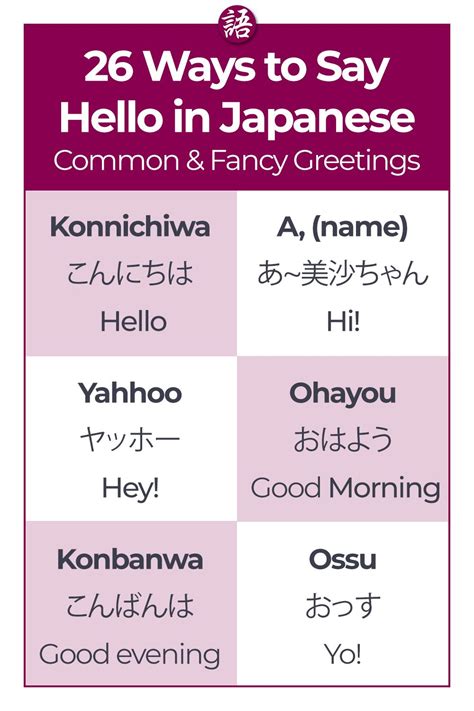How To Say Hello in Japanese: A Comprehensive Guide
Learning how to say hello in a new language is always an exciting first step! Japanese, with its rich culture and complex grammar, might seem daunting at first, but greetings are surprisingly straightforward. This guide will walk you through several ways to say "hello" in Japanese, depending on the time of day and the level of formality.
Basic Japanese Greetings
The most common way to say hello in Japanese is こんにちは (konnichiwa). This is a versatile greeting, suitable for most situations throughout the day. You can use it with friends, colleagues, and even strangers. Think of it as the equivalent of "hello" or "good afternoon" in English.
When to use Konnichiwa:
- Midday: Generally used from late morning until early evening.
- Informal and Formal Settings: Appropriately used in both casual and formal situations.
More Formal Greetings
For more formal settings, such as business meetings or interactions with elders, you might consider these options:
おはようございます (Ohayō gozaimasu)
This translates to "good morning" and is used from sunrise until roughly midday. The use of "gozaimasu" adds a significant layer of politeness and respect.
こんばんは (Konbanwa)
Meaning "good evening," this greeting is used from the late afternoon/early evening until you go to bed. It's a polite and appropriate choice for most situations after the sun starts to set.
Informal Greetings Amongst Friends
If you're chatting with close friends, you can use more casual greetings:
やあ (Yaa)
This is a very informal way to say "hi" or "hey," similar to its English counterparts. Only use this with people you know very well.
もしもし (Moshi moshi)
This greeting is primarily used when answering the phone. It's a unique aspect of Japanese phone etiquette.
Beyond the Basics: Adding Politeness
Japanese culture places a high value on politeness. While the greetings above are generally polite, you can further enhance your politeness by adding:
- Please: Please (ください - kudasai) can be added to requests. For example, "Coffee please" would be コーヒーください (kōhī kudasai).
- Thank you: Arigato (ありがとう - arigatou) or the more formal Arigato gozaimasu (ありがとうございます - arigatou gozaimasu) are essential phrases to learn.
Mastering Japanese Greetings: Tips for Success
- Practice: The best way to learn is to practice! Try saying these greetings out loud to yourself or with a friend.
- Context: Pay attention to the context. Choosing the right greeting will show respect and cultural sensitivity.
- Listen and Learn: Immerse yourself in Japanese media (movies, music, anime) to hear how native speakers use these greetings in natural conversation.
- Resources: Explore online resources like language learning apps and websites for pronunciation guides and practice exercises.
Learning to greet people properly is a crucial aspect of learning any language. By mastering these Japanese greetings, you'll show respect and make a positive impression on those you meet. Good luck with your language learning journey!
